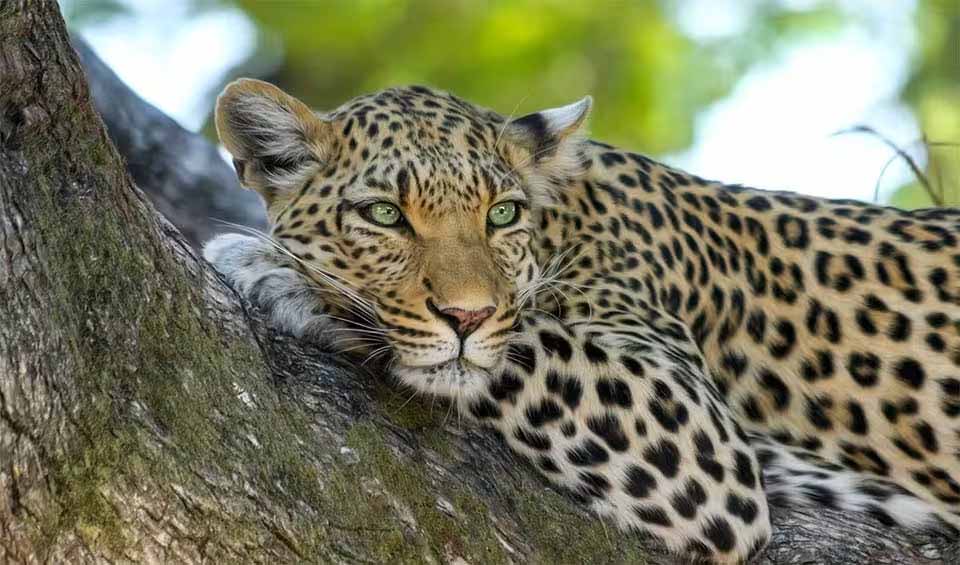Encountering this big cat in its natural habitat is an experience filled with awe, offering a glimpse into the secretive life of one of nature’s most adaptable and skilled predators.
Adapted to a nocturnal lifestyle, leopards are masters of the night, using the cover of darkness to stalk their prey with unmatched stealth and efficiency. However, their adaptability means they can also hunt during the day, especially in areas where they are less likely to be disturbed by human activity. This flexibility in hunting behavior underscores the leopard’s opportunistic nature. Whether scavenging food from other predators or hunting a wide range of prey, leopards demonstrate remarkable dietary versatility. Their prey can range from the smallest of insects, such as termites, to large herbivores weighing up to 100 kg (220 pounds), showcasing their prowess as apex predators capable of taking down animals several times their size.
Leopards are the most geographically widespread of the old-world cats, with nine recognized subspecies that have adapted to a variety of habitats, from the dense rainforests of Africa to the snow-capped mountains of Asia. Despite this adaptability, leopards have been extirpated from much of their historic range due to human activities. Today, their populations are fragmented and isolated, facing an uncertain future in the fragmented landscapes that were once their unchallenged domain.
The threats facing leopards are manifold. Poaching for their beautiful pelts has historically decimated populations, while habitat fragmentation due to agricultural expansion, urban development, and deforestation has dramatically reduced their living spaces. Trophy hunting, often under the guise of conservation, continues to pose a threat by targeting the healthiest individuals within populations, potentially destabilizing the genetic diversity and social structure of remaining groups.
Distribution
 Afghanistan
Afghanistan Official estimate
Official estimate
 Algeria
Algeria Angola
Angola Official estimate
Official estimate
 Armenia
Armenia Azerbaijan
Azerbaijan Bangladesh
Bangladesh Benin
Benin Bhutan
Bhutan Botswana
Botswana Official estimate
Official estimate
 Burkina Faso
Burkina Faso Burundi
Burundi Cambodia
Cambodia Cameroon
Cameroon Central Af. Rep.
Central Af. Rep. Chad
Chad China
China Congo-Brazzaville
Congo-Brazzaville Côte D’ivoire
Côte D’ivoire DR Congo (Kinshasa)
DR Congo (Kinshasa) Djibouti
Djibouti Egypt
Egypt Equatorial Guinea
Equatorial Guinea Eritrea
Eritrea Eswatini
Eswatini Ethiopia
Ethiopia Official estimate
Official estimate
 Gabon
Gabon Official estimate
Official estimate
 Gambia
Gambia Georgia
Georgia Ghana
Ghana Official estimate
Official estimate
 Guinea-Bissau
Guinea-Bissau Official estimate
Official estimate
 Guinea
Guinea Official estimate
Official estimate
 Hong Kong
Hong Kong Official estimate
Official estimate
 India
India Indonesia
Indonesia Iran
Iran Iraq
Iraq Israel
Israel Official estimate
Official estimate
 Jordan
Jordan Official estimate
Official estimate
 Kenya
Kenya Official estimate
Official estimate
 Korea
Korea Official estimate
Official estimate
 Kuwait
Kuwait Official estimate
Official estimate
 Laos
Laos Lebanon
Lebanon Official estimate
Official estimate
 Lesotho
Lesotho Liberia
Liberia Malawi
Malawi Malaysia
Malaysia Mali
Mali Mauritania
Mauritania Official estimate
Official estimate
 Morocco
Morocco Official estimate
Official estimate
 Mozambique
Mozambique Official estimate
Official estimate
 Myanmar
Myanmar Namibia
Namibia Nepal
Nepal Niger
Niger Nigeria
Nigeria North Korea
North Korea Oman
Oman Pakistan
Pakistan Russia
Russia Rwanda
Rwanda Official estimate
Official estimate
 Saudi Arabia
Saudi Arabia Senegal
Senegal Official estimate
Official estimate
 Sierra Leone
Sierra Leone Official estimate
Official estimate
 Singapore
Singapore Official estimate
Official estimate
 Somalia
Somalia South Africa
South Africa Sudan
Sudan Sri Lanka
Sri Lanka Syria
Syria Official estimate
Official estimate
 Tajikistan
Tajikistan Tanzania
Tanzania Thailand
Thailand Official estimate
Official estimate
 Togo
Togo Official estimate
Official estimate
 Tunisia
Tunisia Official estimate
Official estimate
 Turkey
Turkey Turkmenistan
Turkmenistan Official estimate
Official estimate
 UAE
UAE Official estimate
Official estimate
 Uganda
Uganda Uzbekistan
Uzbekistan Official estimate
Official estimate
 Vietnam
Vietnam Yemen
Yemen Zambia
Zambia Zimbabwe
ZimbabweRecent updates
June 2024: Russia and China have established the Land of Big Cats, a 1.75-million-hectare transboundary reserve for Amur leopards and Siberian tigers.
May 2024: An international team led by scientists from DICE, UEA, UCL, NTU, and the Diwan of Royal Court in Oman surveyed the Dhofar mountain range to count Arabia’s last big cats. Using camera traps and DNA analyses, they estimate only 51 wild leopards remain in Oman, spread across three isolated, genetically distinct subpopulations.
Feb 2024: Conservation experts from Saudi Arabia’s Royal Commission for AlUla have successfully bred seven Arabian leopard cubs in captivity this year, aiming to boost the critically endangered species’ wild population.
Feb 2023: Researchers have discovered that Nepal leopards are susceptible to the dog distemper virus, probably resulting in the animals becoming less wary of humans and entering populated areas for food.
Did you know?
- It resembles the jaguar in looks but is smaller and lighter in build; even their rosettes are similar, the leopard’s rosettes just being smaller and missing the central spot as in the jaguars.
- They are very splendid tree climbers and use trees as their comfort zones for resting or feasting.
- Leopards haul and stash heavy carcasses on tree branches away from other ground predators, thanks to powerful jaws and large skulls!
- Leopards are shy and reclusive and avoid humans but can attack humans in close encounters; after all, the only thing about leopard behavior that is completely predictable is its unpredictability!
- Around 4,500-7,000, leopards are killed annually to meet the demand for leopard skins by Nazareth Baptist (Shembe) Church members only. In SA, the illegal trafficking of leopard skins for cultural regalia is popular.
- Leopards are also hunted for their skins (used in traditional ceremonies) and other body parts for medicinal use in Chinese and eastern cultures, negatively impacting local Leopard populations.
- They are the most adaptive big wild cats (pantheras), yet disappearing at an alarming rate.
- Leopard parts are used as substitutes for tiger parts in the black market, triggering large-scale leopard hunting.
Anything we've missed?
Help us improve this page by suggesting edits. Glory never dies!
Suggest an editGet to know me
Terrestrial / Aquatic
Altricial / Precocial
Polygamous / Monogamous
Dimorphic (size) / Monomorphic
Active: Diurnal / Nocturnal
Social behavior: Solitary / Pack / Herd
Diet: Carnivore / Herbivore / Omnivore / Piscivorous / Insectivore
Migratory: Yes / No
Domesticated: Yes / No
Dangerous: Yes / No
Leopard on banknotes










